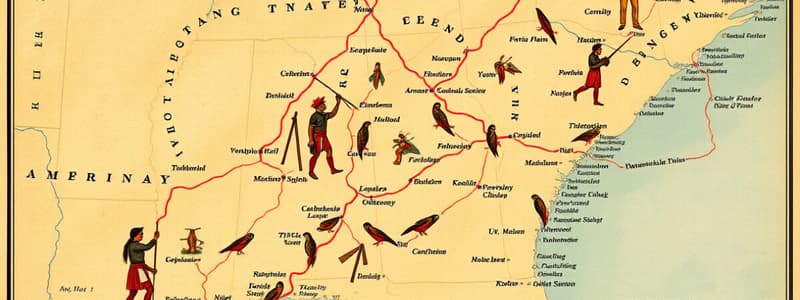Podcast
Questions and Answers
What was a key reason early Native Americans were attracted to the Coastal Plain region of North Carolina?
What was a key reason early Native Americans were attracted to the Coastal Plain region of North Carolina?
- Presence of large animal herds
- Rich mineral deposits
- Fertile land and abundant water supplies (correct)
- Proximity to mountains
Which of the following tribes is NOT considered one of the three main Coastal Plain Indian Tribes?
Which of the following tribes is NOT considered one of the three main Coastal Plain Indian Tribes?
- Cherokee (correct)
- Algonquian
- Siouan
- Tuscarora
What unique item was used by the Coastal Plain tribes for storytelling and as gifts?
What unique item was used by the Coastal Plain tribes for storytelling and as gifts?
- Wampum jewelry (correct)
- Beaded headdresses
- Wooden totems
- Fur cloaks
How did Algonquian Indians' lack of a written language impact their communication?
How did Algonquian Indians' lack of a written language impact their communication?
What geographical feature did the Algonquian Indians build their villages upon to avoid flooding?
What geographical feature did the Algonquian Indians build their villages upon to avoid flooding?
Flashcards are hidden until you start studying
Study Notes
Coastal Plain Region
- The Coastal Plain region of North Carolina had a hospitable climate and ample natural resources.
- Fertile land and abundant water sources attracted early Native American tribes.
- The region provided a warm climate and diverse food resources, essential for survival.
Main Coastal Plain Tribes
- The three primary tribes were the Algonquian, Siouan, and Tuscarora.
- Siouan tribe, also known as the Waccamaw Siouan, shared cultural similarities despite differing languages.
- Trade was vital among these tribes, especially with unique items like wampum, used for storytelling and gifts.
Algonquian Tribe
- Ancestors of the Algonquian traveled from regions such as New York and the Great Lakes over 10,000 years ago.
- Settled in the Tidewater area, specifically around the Albemarle Sound and Pamlico River, living there for over 800 years.
- Lacked a written language; communication was purely oral.
- Villages were built on high mounds to avoid flooding, enhancing survival rates.
Fishing and Occupation
- Developed advanced fishing techniques using fire-hollowed canoes and netted fencing, targeting local fish like flounder, trout, and mullet.
- Oysters were also a major food source.
- Proficient hunters, utilizing bows and arrows for hunting deer, beavers, foxes, rabbits, and black bears, and were skilled farmers growing crops like corn, pumpkins, beans, squash, and tobacco.
Housing and Defense
- Villages were often fortified with palisades, a wooden fence serving as a defensive stockade.
- Early homes, wigwams, were dome-shaped structures made from bent twigs, covered with birchbark and reeds, with a smoke hole at the top.
- Transitioned to longhouses, larger structures built from flexible saplings, reaching lengths of 30 to 50 feet and similarly covered.
Decline of the Algonquian
- Algonquian tribe suffered population decline due to conflicts with the Tuscarora and diseases introduced by white settlers.
- Illnesses like smallpox, influenza, and measles devastated their communities, forcing survivors to relocate further north.
Waccamaw Siouan Tribe
- Known as the "People of the Fallen Star," linked to a tribal legend of Lake Waccamaw's creation.
- Utilized a semi-nomadic lifestyle focusing on hunting, gathering, and farming.
- Gender roles assigned men to hunting and farming, while women were involved in gathering, clothing production, and crafting goods for trade.
- Homes typically dome-shaped and covered in bark, designed for mobility.
Impact of Colonization
- Waccamaw Siouan Indians sought refuge in greener areas like the Green Swamp to escape colonization pressures.
- Their lifestyle adapted to safeguard against newer threats posed by European settlers.
Studying That Suits You
Use AI to generate personalized quizzes and flashcards to suit your learning preferences.




